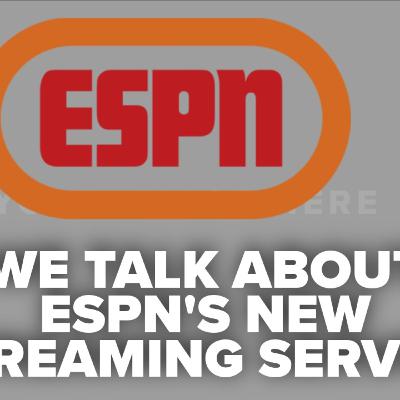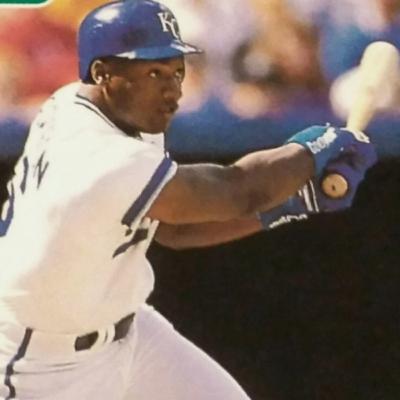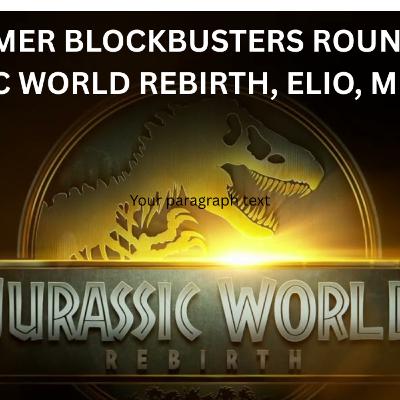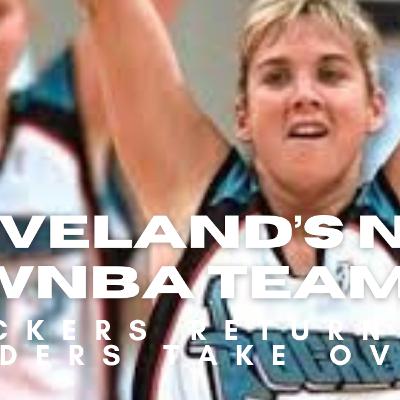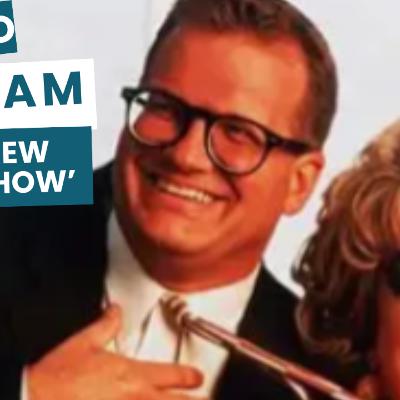Discover View From The Pugh
View From The Pugh

View From The Pugh
Author: Chris Pugh
Subscribed: 1Played: 64Subscribe
Share
© Chris Pugh
Description
Podcast from Chris Pugh, Craig Shoup, Joe Frost and Paul Yanchek with regular guest appearances from Robert McCune, George Thomas and Bob Garver that discusses pop culture and sports.
Check out our Anchor page at https://anchor.fm/TheOhioan
Check out our Anchor page at https://anchor.fm/TheOhioan
1892 Episodes
Reverse
Starting August 21, ESPN will officially enter the direct-to-consumer (DTC) streaming space with a full-fledged service that doesn’t require a cable subscription. Priced at $29.99/month, this new ESPN offering isn’t just a beefed-up version of ESPN+. It’s a digital replacement for the traditional cable bundle — and it may mark the beginning of the end for how we've watched sports for decades.With this move, ESPN is finally giving fans full access to live sports, original shows, and premium content directly through an app — no cable login, no middleman, no bundles. The service comes as ESPN’s parent company, Disney, is working on a groundbreaking deal: giving the NFL an ownership stake in ESPN itself. That deal, pending regulatory approval, would make the NFL not just a content partner but a literal co-owner in the media company broadcasting its games.That’s big.It signals a seismic shift in the power dynamics of sports media. As leagues like the NFL gain leverage through ownership and direct distribution, cable’s hold on the sports world weakens.But that’s not the only major player entering the fray. Fox is also launching Fox One, a new $20/month DTC streaming service that will offer access to all its sports, news, and entertainment content — including NFL games, World Series broadcasts, and more.Now, with ESPN and Fox One going direct, the big question is: are we finally heading toward à la carte sports streaming?Not quite — but we’re closer than ever.These separate services might soon evolve into a sports streaming bundle, combining the likes of ESPN, Fox, and perhaps even other networks like TNT or NBC. The goal: give fans a streamlined, digital-first way to access all their favorite teams and leagues without jumping through multiple apps — or worse, sticking with overpriced cable packages.For consumers, the shift presents both promise and problems. On one hand, you’re finally getting the flexibility and control streaming has long promised. On the other, stacking $29.99 for ESPN, $20 for Fox, and potentially $15-$20 for other services quickly adds up.Still, this is a turning point. Sports has long been the glue holding cable together. But now, the biggest names in sports media are pulling that glue apart — and replacing it with apps, bundles, and direct deals that favor digital-first fans.If you're a diehard sports viewer, this is your cue to start reevaluating your subscriptions. The way you watch football this fall may never be the same again.
(EDITOR’S NOTE: View From The Pugh is a journalism project from Chris Pugh. Subscribe to his daily newsletter and podcast, follow him on YouTube and sponsor his work)Today’s post is sponsored by StreamYard.In a wide-ranging conversation, the hosts covered everything from football field battles to ethical battles in the animal world — and even some light-hearted humor to wrap things up.The sports segment began with anticipation for the Pittsburgh Steelers’ upcoming preseason game against the Jacksonville Jaguars. Fans are eager to see how the roster is shaping up, especially with the potential return of quarterback Kenny Pickett. His presence could inject much-needed energy into the offense, but all eyes will be on how he performs after injury concerns.One of the big roster stories is the release of Montana Lemonius-Craig, a move that could have ripple effects on depth and competition. The hosts examined how recent cuts and signings might influence final roster decisions.The conversation naturally shifted to the NFL’s new collective bargaining agreement. The hosts explored how changes in contract structure, player incentives, and cap management might alter the way teams operate — especially for young players entering the league.From there, the discussion took a collegiate turn, highlighting Ohio State University’s game-day enhancements. The Buckeyes are adding new traditions to Ohio Stadium, including a victory bell and a specially curated soundtrack for fans. While some traditionalists may resist change, the hosts agreed these updates could boost fan engagement and create an even more electric atmosphere.The most surprising — and controversial — topic was a story from Denmark. A zoo there has made international headlines for a pet adoption program that doesn’t rehome animals but instead uses them as food for predators. This includes euthanizing small pets and feeding them to larger animals in the zoo.Social media reaction has been sharply divided. Supporters like Annika Krogs card praised the zoo’s transparency and practicality, while critics like Karina Jensen argued the public outrage was missing the bigger ethical picture. The zoo’s own Facebook post requesting donations of animals drew intense criticism and sparked broader debates about animal welfare, transparency, and public relations strategy.The hosts considered whether the zoo’s honesty helped or hurt its public image, and how such a controversial move might be spun into a more favorable narrative.The episode ended on a lighter note, with humorous speculation about how the zoo’s PR department could creatively reframe the story — proof that even heavy discussions can have moments of levity.With sports insights, PR analysis, and ethical debates, this conversation had something for everyone.
(EDITOR’S NOTE: View From The Pugh is a journalism project from Chris Pugh. Subscribe to his daily newsletter and podcast, follow him on YouTube and sponsor his work)Today’s post is sponsored by StreamYard.The Cleveland Browns are heading into a crucial stretch of training camp with more questions than answers at quarterback. Injuries to Kenny Pickett and Dillon Gabriel have turned what was a four-man race into a battle between just two healthy players. Joe Flacco is expected to start, but the uncertainty surrounding the backup role leaves the team in a tricky position.Chris and Mike, in their latest sports discussion, examined how these injuries might shift the Browns’ game plan. Flacco’s veteran presence brings stability, but in an NFL season where depth is crucial, the backup quarterback could make or break a playoff push.Adding to the Browns’ challenges is the suspension of running back Quinshon Judkins. His absence could force the Browns to lean more heavily on their passing game — a strategy that may falter without a legitimate top-tier wide receiver. Chris and Mike agreed that finding an offensive playmaker should now be a front-office priority.Over in Columbus, the Ohio State Buckeyes are gearing up for their own quarterback decision. Multiple candidates are in the mix, creating healthy competition in the QB room. This battle, paired with one of the most dangerous running back tandems in the country, gives head coach Ryan Day a versatile playbook to work with. The depth on offense could be the deciding factor in Ohio State’s push for a national title.On the baseball front, the Cleveland Guardians made several moves at the MLB trade deadline aimed at bolstering their roster for the playoff race. The duo debated whether the Guardians addressed their biggest needs and if the front office should have been more aggressive. With a competitive American League Central, every roster decision will be magnified in the coming months.The conversation wrapped up with a look at March Madness — and the possibility of expanding the NCAA Tournament. Chris and Mike discussed whether adding more teams would enhance the event’s excitement or dilute its uniqueness. While expansion could mean more Cinderella stories, it could also mean longer schedules and fewer upsets.From the Browns’ quarterback battle to the Guardians’ playoff push and Ohio State’s championship aspirations, Ohio sports fans have plenty to watch as summer turns to fall.
There’s something oddly comforting about the feel of an old pack of baseball cards—the slight crackle as it opens, the glossy player photos, and the faint smell of cardboard and ink. In this episode, I took a nostalgic journey back into the junk wax era by opening a pack of 1991 Score baseball cards, and it brought a flood of memories.Score’s 1991 set was massive—893 cards, all with bright, bold borders that changed color based on a player’s position. It wasn’t just a card set; it was a rainbow in a box. And that visual flair, combined with a player checklist that spanned stars, role players, and everything in between, made every pack an unpredictable delight.Some names jumped right off the card: Bo Jackson, the legendary two-sport athlete; Jose Canseco, the slugging superstar of the Oakland A’s; and Roberto Alomar, one of the smoothest second basemen of the era. But even lesser-known players like Jeff Russell and Steve Geltz added to the fun—each name tugging at some memory from old games, TV broadcasts, or neighborhood trades.Sure, the trivia on the back is nearly unreadable thanks to the microscopic font size, but it’s still packed with fun facts and full career stats. Score put real effort into giving fans substance, not just style.The term “junk wax” may sound dismissive, but for many of us, these cards were our entry point into baseball, collecting, and dreaming. We didn’t care that there were too many printed. We cared that we could afford them, trade them, and build entire afternoons around sorting and stacking them.Today, those cards might not be worth much in dollars, but they’re priceless in nostalgia.This episode is a celebration of that feeling. I hope it sparks memories for you, too.
Is Punxsutawney Phil really the weather expert we treat him as every February 2nd, or just a lovable groundhog caught in a centuries-old publicity stunt?In this episode, we dig into a recent Fox News report that took a closer look at Phil’s 2025 prediction of “six more weeks of winter.” Spoiler alert: it didn’t quite pan out. The lower 48 states were actually 0.4°F warmer than average in the six weeks following Groundhog Day. So was Phil wrong? Or are we misinterpreting what he’s actually predicting?Speaker 1 cites the national data and questions Phil’s legitimacy as a forecasting icon. Meanwhile, Speaker 2 and Speaker 3 jump in to defend the furry forecaster, noting that Phil has been correct in several key years—including 2016, 2020, and 2024. They suggest that judging him on national averages might be unfair when his predictions originate from Punxsutawney, Pennsylvania. Should Phil be held to national weather trends—or just local ones?The conversation quickly expands beyond weather accuracy. Is Phil’s role more about tradition and spectacle than science? Should we expect meteorological precision from a rodent? Or is Phil’s prediction just part of the fun that kicks off each February?Things get even more interesting as the group touches on the politicization of weather reporting. Is it possible that interpretations of Phil’s predictions are being filtered through partisan lenses? Does making Phil “wrong” or “right” carry weight in climate debates? Or are we overthinking a tradition that’s mostly for show?No matter your stance, there's no denying Phil's iconic status. Groundhog Day draws national attention every year, and his shadow (or lack thereof) still makes headlines. But in an era of data-driven meteorology and climate scrutiny, some are asking: is it time to retire the idea that Phil is anything more than entertainment?We also take a moment to explore the culture and tourism surrounding Punxsutawney, how Phil has become a symbol far beyond weather, and why this light-hearted event endures in American pop culture.So what do you think? Is Phil just a furry meteorological mascot—or should he be held accountable when his shadow misleads millions?
In this episode, we dive into a sizzling, hilarious, and surprisingly heartfelt discussion about America’s most iconic fast-food chain—McDonald’s. From nostalgic throwbacks to the shocking truth about today’s prices, our conversation is a Big Mac-sized combo of memories, humor, and fast-food philosophy.We kick things off with a fascinating look at a Fox News article comparing 1991 McDonald’s prices to today’s menu. Imagine getting a hamburger for 75 cents or a Big Mac for under two bucks! Speaker 1 recalls this revelation—and his wife’s mock horror over how often he still chooses McDonald’s. But who can blame him? Whether it’s fries, nuggets, or a double cheeseburger, McDonald’s has been a constant in many of our lives.From there, we dig into some of the chain’s biggest swings and misses, including the long-forgotten McDonuts. Remember those? Probably not—and for good reason. The group also dives into some of the more frustrating aspects of the current menu, such as the challenge of ordering a plain iced coffee with no flavor shots or added sugar. Why is that so complicated?We broaden the conversation by comparing McDonald’s to rising competitors like Sheetz and Buc-ee’s. Speaker 2 makes the case for Sheetz’s build-your-own burger experience, while Speaker 3 waxes poetic about Buc-ee’s brisket sandwiches and unmatched convenience store vibes. Is McDonald’s falling behind in the fast-food arms race?But it’s not just about food—it’s also about feelings. McDonald’s has a way of bringing out strong opinions. One person might crave the salty fries after a rough day, while another sees it as the symbol of American excess. Whether it’s a guilty pleasure or a nostalgic comfort, it’s hard to ignore the golden arches.Along the way, the group shares some laugh-out-loud moments, including the story of a doomed attempt to sneak a McChicken into a fancier restaurant, and the universal frustration of ice cream machines “being down.” We also get into regional menu differences and why the breakfast cutoff time still feels like a personal betrayal.Ultimately, this episode is a celebration and critique of a fast-food institution. It’s about the joy, the disappointment, the nostalgia—and yes, the price hikes—that come with loving (or leaving) McDonald’s. From the days of dollar menus to today’s multi-app ordering chaos, we cover it all.Whether you’re a McLoyalist or you’ve moved on to trendier chains, you’ll find something to chew on in this fast-food-fueled conversation.
(EDITOR’S NOTE: View From The Pugh is a journalism project from Chris Pugh. Subscribe to his daily newsletter and podcast, follow him on YouTube and sponsor his work)Today’s post is sponsored by StreamYard.This week on our movie review roundup, national film critic Bob Garver returns to the mic with thoughts on some of the biggest titles currently in theaters. From Pixar’s latest space adventure to the newest Jurassic World installment, we dive deep into the hits—and misses—of summer 2025.The conversation starts with Jurassic World: Rebirth, which brings dinosaurs back for another round of chaos. Featuring big names like Scarlett Johansson and Mahershala Ali, the movie focuses on a mission to extract dinosaur DNA to cure heart disease. While some suspenseful moments work—especially one cliffside scene reminiscent of West Virginia’s famous bridge walk—Bob found the movie predictable and uninspired. Final Grade: CShifting to animation, Pixar’s Elio may not be crushing the box office, but it earns a warm recommendation from Bob. The story follows a young boy abducted by aliens and thrust into an intergalactic United Nations. It blends the emotional heart of Lilo & Stitch with the buddy dynamics of How to Train Your Dragon. Bob found it touching and visually stunning—deserving of more love than it’s currently getting. Final Grade: B-In the horror world, 28 Years Later marks the long-awaited return of director Danny Boyle and writer Alex Garland. Set in a post-zombie-apocalypse world, the story follows a teenager raised in isolation from the infected mainland. With standout performances from Aaron Taylor-Johnson, Jodie Comer, and Ralph Fiennes, the film blends thrilling zombie action with emotional depth. Final Grade: BBrad Pitt's F1 takes the high-speed action of Top Gun: Maverick and transposes it to the world of Formula One racing. Unfortunately, Bob found it derivative, overlong, and visually overwhelming without substance. If you’ve seen Top Gun, or any racing movie really, this one won’t feel fresh. Final Grade: C-M3GAN 2.0, the sequel to the viral 2022 hit, takes the franchise in a more action-oriented direction—much to its detriment. Bob felt the sequel lacked the original’s charm and horror balance. While the killer doll Megan is still entertaining, the rest of the cast phones it in. Final Grade: CBob concludes the episode looking forward to more promising titles coming later this month, including Fantastic Four and Superman. His advice? Skip the reboots and sequels unless you’re a diehard fan, and don’t overlook the underrated gems like 28 Years Later or Elio.
(EDITOR’S NOTE: View From The Pugh is a journalism project from Chris Pugh. Subscribe to his daily newsletter and podcast, follow him on YouTube and sponsor his work)Today’s post is sponsored by StreamYard.This week on our movie review roundup, national film critic Bob Garver returns to the mic with thoughts on some of the biggest titles currently in theaters. From Pixar’s latest space adventure to the newest Jurassic World installment, we dive deep into the hits—and misses—of summer 2025.The conversation starts with Jurassic World: Rebirth, which brings dinosaurs back for another round of chaos. Featuring big names like Scarlett Johansson and Mahershala Ali, the movie focuses on a mission to extract dinosaur DNA to cure heart disease. While some suspenseful moments work—especially one cliffside scene reminiscent of West Virginia’s famous bridge walk—Bob found the movie predictable and uninspired. Final Grade: CShifting to animation, Pixar’s Elio may not be crushing the box office, but it earns a warm recommendation from Bob. The story follows a young boy abducted by aliens and thrust into an intergalactic United Nations. It blends the emotional heart of Lilo & Stitch with the buddy dynamics of How to Train Your Dragon. Bob found it touching and visually stunning—deserving of more love than it’s currently getting. Final Grade: B-In the horror world, 28 Years Later marks the long-awaited return of director Danny Boyle and writer Alex Garland. Set in a post-zombie-apocalypse world, the story follows a teenager raised in isolation from the infected mainland. With standout performances from Aaron Taylor-Johnson, Jodie Comer, and Ralph Fiennes, the film blends thrilling zombie action with emotional depth. Final Grade: BBrad Pitt's F1 takes the high-speed action of Top Gun: Maverick and transposes it to the world of Formula One racing. Unfortunately, Bob found it derivative, overlong, and visually overwhelming without substance. If you’ve seen Top Gun, or any racing movie really, this one won’t feel fresh. Final Grade: C-M3GAN 2.0, the sequel to the viral 2022 hit, takes the franchise in a more action-oriented direction—much to its detriment. Bob felt the sequel lacked the original’s charm and horror balance. While the killer doll Megan is still entertaining, the rest of the cast phones it in. Final Grade: CBob concludes the episode looking forward to more promising titles coming later this month, including Fantastic Four and Superman. His advice? Skip the reboots and sequels unless you’re a diehard fan, and don’t overlook the underrated gems like 28 Years Later or Elio.
(EDITOR’S NOTE: View From The Pugh is a journalism project from Chris Pugh. Subscribe to his daily newsletter and podcast, follow him on YouTube and sponsor his work)Today’s post is sponsored by StreamYard.Cleveland’s plan to build a new Browns stadium has sparked both excitement and debate, particularly due to its unique financing approach. A key part of the project’s funding—$600 million—will come from unclaimed funds managed by the state of Ohio, which has stirred mixed reactions among residents and stakeholders.Unclaimed funds represent money from various forgotten or abandoned accounts, including bank deposits, insurance claims, and uncashed checks. When rightful owners don’t claim these funds within a designated period, they revert to the state treasury. With a total pool of about $3.7 billion, Ohio has allocated $600 million of this dormant money toward constructing a modern, multi-use stadium for the Browns.This allocation has raised eyebrows. Some question whether it is appropriate to use these funds for a sports facility rather than saving them for emergencies, returning them to taxpayers, or investing in other public services. However, supporters argue that investing in the stadium can generate long-term economic benefits for Cleveland and the wider region.The new stadium is designed to be more than just a football venue. Unlike the current FirstEnergy Stadium, which primarily hosts Browns games, the new facility aims to attract concerts, conventions, and large-scale events year-round. This diversified use is expected to increase visitation, create more jobs, and stimulate local businesses, from restaurants to hotels.Community members hope that the stadium will serve as a catalyst for urban revitalization in Northeast Ohio. By drawing tourists and event-goers, the project could boost the local economy and enhance Cleveland’s reputation as a vibrant, dynamic city. Improved infrastructure, increased employment opportunities, and new entertainment options are among the anticipated benefits.Still, the project’s funding source remains a sticking point for some. Unclaimed funds, while “found money,” originally belong to individuals who might not yet have claimed them. The concern is whether the state is adequately safeguarding these assets or risking public trust by redirecting the money to high-profile projects like a stadium.Ohio officials and project leaders emphasize transparency and the legal framework surrounding unclaimed funds. They assure the public that efforts to notify and reunite rightful owners with their money continue alongside the stadium plan. Furthermore, they highlight that the stadium’s economic and cultural contributions could far outweigh initial concerns over the funding source.As Cleveland moves forward, the Browns stadium symbolizes more than just a sports venue; it represents a test case for innovative public financing and community impact. Balancing fiscal responsibility with growth potential will be key to the project’s success and public acceptance.Residents and fans alike should stay informed and engaged as this ambitious plan progresses. The stadium has the potential to transform the region’s sports and entertainment landscape—but only time will tell if the investment in unclaimed funds proves to be a winning play for Cleveland.
(EDITOR’S NOTE: View From The Pugh is a journalism project from Chris Pugh. Subscribe to his daily newsletter and podcast, follow him on YouTube and sponsor his work)Today’s post is sponsored by StreamYard.The announcement of Cleveland as one of three expansion cities for the WNBA’s 2028 season has sparked excitement and anticipation across the sports world. After a 25-year absence, professional women’s basketball is returning to “The Land” with a new franchise, promising fresh opportunities for fans, players, and the community alike.Cleveland was an original WNBA market with the Rockers, a team that played from 1997 until 2003. The Rockers left behind a legacy of dedicated fans and a foundation of women’s professional sports in the city. Now, as the league expands, Cleveland has the chance to redefine that legacy and build something bigger and better.One of the most talked-about topics is the team’s name. Fans and commentators are debating whether to bring back the Cleveland Rockers or to embrace a new identity. The name “Spiders” has emerged as a strong contender, linking the team to the city’s beloved minor league baseball history. Others propose names like Lady Cavs or Lady Kings, tying the new team to Cleveland’s NBA heritage and basketball culture. Each option reflects different visions for the team’s identity and connection to local sports traditions.Beyond the name, the challenge lies in attracting fans and gaining media attention. The WNBA has historically faced struggles with visibility compared to the NBA, despite growing viewership and impressive talent. Players like Caitlyn Clark and Angel Reese symbolize the new generation of stars bringing excitement and drawing attention to the league. Cleveland’s team has the potential to become a home for such talent, inspiring local youth and energizing basketball fans.The cultural and media treatment of the WNBA remains a key hurdle. Women’s sports often receive less coverage and lower attendance than men’s leagues. However, the momentum behind women’s basketball is undeniable, and Cleveland’s strong sports culture offers fertile ground to grow the fanbase. With effective marketing and community engagement, the new WNBA team can thrive and elevate women’s sports visibility in the region.As Cleveland prepares for the WNBA’s arrival, the city stands on the brink of a new sports era. The excitement over team names, the return of professional women’s basketball, and the opportunity to champion female athletes all point to a promising future. Whether the team is called the Rockers, Spiders, or another creative name, one thing is clear: Cleveland’s WNBA journey is just beginning, and the whole city will be watching.
(EDITOR’S NOTE: View From The Pugh is a journalism project from Chris Pugh. Subscribe to his daily newsletter and podcast, follow him on YouTube and sponsor his work)Today’s post is sponsored by StreamYard.As Independence Day approaches, Ohioans are preparing for one of the year’s most dazzling traditions: fireworks. Whether you’re heading to a major city display in Cleveland or a small-town celebration in Warren, there’s something magical about the night sky lighting up in red, white and blue.In this week’s podcast episode, we explore the past, present, and future of fireworks in Ohio. We start with a nostalgic look at fireworks displays at the old Cleveland Stadium—an era where Browns owner Art Modell used them not just to entertain fans but to market the team. For many, those shows were more than an event; they were a memory in the making.But not everyone experiences fireworks the same way. For pet owners and individuals with autism, July 4th can bring anxiety rather than excitement. The loud booms and unexpected explosions are stressful, raising important questions about how to make celebrations more inclusive.We also touch on how Ohio’s fireworks laws have changed in recent years, allowing more people to shoot off their own fireworks at home. While this has created more localized displays, it’s also raised safety and noise concerns, turning once-quiet neighborhoods into explosive battlegrounds.Logistically, attending large events still has its hurdles—traffic jams, unpredictable weather, and the hunt for a good viewing spot can wear down even the most enthusiastic revelers. Still, the energy and excitement of a well-organized community event can make it all worth it.Looking ahead to 2026, when America celebrates its 250th birthday, we ask: can we do better? Could Ohio communities create more coordinated, family-friendly, and inclusive events that reflect the spirit of unity?Ultimately, fireworks are about more than spectacle. They’re a shared experience—of pride, of joy, of reflection. This Fourth of July, whether you're under stadium lights or sparklers in your backyard, may it be safe, fun, and full of connection.🎇 Got a favorite fireworks memory or a tip to make the most of July 4th? Drop a comment and join the conversation!
(EDITOR’S NOTE: View From The Pugh is a journalism project from Chris Pugh. Subscribe to his daily newsletter and podcast, follow him on YouTube and sponsor his work)Today’s post is sponsored by StreamYard.The Pittsburgh Steelers have made headlines once again, this time with a blockbuster trade that could reshape their 2025 season. The team has acquired All-Pro cornerback Jalen Ramsey and tight end Jonnu Smith from the Miami Dolphins in exchange for star safety Minkah Fitzpatrick and a pick swap. It’s a move that signals Pittsburgh’s aggressive push to win now.Ramsey brings a championship pedigree and elite shutdown skills to a defense that is rapidly becoming one of the NFL’s best. Alongside newly acquired Darius Slay, the Steelers’ secondary will be a nightmare for opposing quarterbacks. Smith, meanwhile, adds a dynamic presence in the middle of the field. After setting a franchise record for receptions with Miami last season, he becomes a perfect target for newly signed quarterback Aaron Rodgers.Rodgers now has an offense stacked with talent—DK Metcalf, Najee Harris, and Smith create a trio of threats that few defenses can contain. The only question is how quickly the chemistry can develop in a division that doesn’t allow for slow starts.From Miami’s perspective, the trade makes sense financially. With the salary cap tightening, they shed two massive contracts and bring back Fitzpatrick, a former Dolphin and one of the league’s best at his position. The pick swap gives them additional flexibility as they retool for the future.But even with all these moves, there’s skepticism. Some analysts still rank the Steelers as the fourth-best team in the AFC North, a testament to how strong the division is. The Bengals remain elite with Joe Burrow, the Ravens are dangerous with Lamar Jackson, and the Browns may be poised for a breakout if Deshaun Watson returns to form.The key question for Pittsburgh is simple: can all these big names gel in time to contend?With Super Bowl aspirations and a stacked roster, the pressure is on. If it all comes together, this could be one of the most memorable seasons in recent Steelers history. If not, it may go down as a cautionary tale of trying to buy a championship.Either way, fans are in for a wild ride.
(EDITOR’S NOTE: View From The Pugh is a journalism project from Chris Pugh. Subscribe to his daily newsletter and podcast, follow him on YouTube and sponsor his work)Today’s post is sponsored by StreamYard.For fans of ‘90s television, few shows encapsulated the era’s quirky charm like The Drew Carey Show. Set in Cleveland and centered around an average guy navigating a dead-end job and absurd workplace politics, the sitcom became a cultural icon—especially in the Midwest. But for years, fans were left asking the same question: why can’t we stream it?Now, there’s good news... with a caveat.The Drew Carey Show is finally available on major platforms like Amazon and Apple TV. However, unlike other classic sitcoms that come bundled with subscription services, viewers will have to pay per episode—$2.99 each, to be exact. For those hoping to binge all nine seasons, the cost adds up quickly.So why the delay, and why the steep price?The answer lies in music rights. During its original run, The Drew Carey Show frequently featured popular music—from opening numbers to dream sequences and dance breaks. While these made the show special, they also created licensing hurdles that complicated its distribution in the streaming era. Negotiating rights for every track used across the series took years to sort out.This long-awaited return is a bittersweet victory for fans. On one hand, the show’s availability means younger audiences can finally discover it. On the other hand, the pay-per-view model feels outdated in an era of binge culture. Still, for many, the cultural value outweighs the price.For Northeast Ohioans, the show holds even deeper significance. Rarely has a major network sitcom been so proudly rooted in Cleveland. From shout-outs to the Browns and Indians (now Guardians) to its blue-collar humor and unfiltered love for the city, the show was more than just funny—it was familiar.In a recent podcast episode, media analysts Chris and Guy explored this return in detail. Guy even shared a personal story about meeting Drew Carey at a Cleveland Browns game, reinforcing the show's close connection with its hometown roots.Their conversation also touched on how the rise of streaming is reshaping access to both legacy TV and live sports. With the NFL, MLB, and other leagues making streaming deals, consumers are forced to juggle subscriptions or pay à la carte—a trend that The Drew Carey Show’s re-release exemplifies.In the end, The Drew Carey Show is back. It's not the easiest or cheapest to watch—but for die-hard fans and nostalgia lovers, it’s a welcome return. Let’s just hope this signals a broader effort to bring more classic shows—music rights and all—back into the digital age.
(EDITOR’S NOTE: View From The Pugh is a journalism project from Chris Pugh. Subscribe to his daily newsletter and podcast, follow him on YouTube and sponsor his work)Today’s post is sponsored by StreamYard.If your morning cereal started committing crimes, would you still eat it?That’s the question swirling around Cinnamon Toast Crunch’s latest marketing campaign, “Must Synod Us,” which reimagines its lovable cereal mascots as darkly comic cannibals. Inspired by the tone of true crime content and the sharp wit of modern internet humor, the campaign is both boldly creative and wildly controversial.The ad spots feature animated cereal pieces plotting and executing the (sometimes literal) consumption of their fellow squares. There are red-tinted scenes, mock-interviews, and over-the-top dramatizations that wouldn’t feel out of place in a parody of Dateline NBC. The phrase “Must Synod Us” plays off both religious and crime-related themes, as if the cereal is confessing its sins — before devouring its brethren.So, what’s the goal here?Clearly, this isn’t aimed at children. Instead, the campaign seems to target millennial and Gen X adults, particularly the true crime-obsessed crowd. Think moms who fall asleep to podcasts about unsolved murders and love an ironic twist in their advertising.But while the concept is undeniably creative, the reaction has been mixed.On the one hand, the campaign has gone viral — drawing millions of views and plenty of commentary. On the other, critics question whether showing your product eating itself is a great way to encourage people to, well, eat it.And therein lies the great marketing paradox:🎯 Is it better to go viral, or to sell more cereal?There’s no doubt the ads are memorable. But is “memorable” enough if it makes consumers uneasy about pouring your product into a bowl?Some marketing experts applaud the campaign’s risk-taking and creative storytelling. They argue that in an oversaturated media landscape, shock and satire are effective tools — especially when trying to engage distracted, digital-native audiences. Others worry it crosses the line into being distasteful, unsettling, and just plain weird for a food brand.And what about the kids who still eat Cinnamon Toast Crunch?Are they being phased out in favor of ironic internet humor?Only time — and sales numbers — will tell.In the meantime, one thing’s for sure: breakfast will never look the same again.
💩 It’s one of the most infamous cruise stories of the 21st century — the “Poop Cruise.” In this episode, we revisit the 2013 Carnival Triumph disaster, when a fire in the engine room left more than 4,000 passengers and crew stranded at sea for four harrowing days… without power, plumbing, or peace.What happened on board was equal parts horrifying and bizarre:🚽 Overflowing toilets🛑 No air conditioning🔦 No electricity🛏️ Tent cities on deck💼 Red biohazard bags distributed for human waste🍹 An open bar to "boost morale" (that backfired fast)🤦♂️ Fights, public sex, and drunken chaosAll of it occurred under the baking Gulf sun, with raw sewage spilling into hallways and passengers sleeping in makeshift shelters above deck. It was a moment that challenged cruise line reputation — and the limits of human dignity.🗣️ In this conversation, we explore:What caused the Carnival Triumph to fail so dramaticallyFirsthand passenger accounts and media coverage of the crisisCarnival’s unusual response strategies, like the open bar and free future cruisesThe long-term PR nightmare this created for the cruise industry🚢 But we don’t stop there. We dive into the Titanic vs. Poop Cruise discussion — one historical, one horrifying (in a different way).While the Titanic ended in tragedy, it also became a cultural touchstone, forever romanticized in film and memory. The Poop Cruise? Not so much. But should it be? Could it have marketing potential?We jokingly explore:A Carnival “Poop Cruise Experience” theme nightThe ethics of profiting off disaster tourismWhy some people would probably pay for the T-shirt that says, “I survived the poop cruise”💬 Join us for a mix of dark humor, history, and cruise ship crisis management gone completely sideways.This episode blends absurdity with analysis — because sometimes, the worst-case scenario is just too unbelievable to ignore.🎧 Don’t forget to subscribe for weekly dives into strange history, weird news, and thoughtful discussion (even if it’s about poop).👇 Let us know in the comments:Would you ever get on a Carnival cruise after this?Titanic or Triumph — which would YOU rather be on?Is there such a thing as funny disaster tourism?
(EDITOR’S NOTE: View From The Pugh is a journalism project from Chris Pugh. Subscribe to his daily newsletter and podcast, follow him on YouTube and sponsor his work)🔥 From blackouts in Cleveland to bombings overseas, this week’s episode dives deep into the chaos — both local and global — and tosses in a bold political thought experiment for good measure.We start with the Cleveland power outage, one of many heat wave-related disruptions affecting the region. As temperatures soar across the U.S., infrastructure continues to buckle under pressure. Is our grid ready for more extreme weather?🇮🇷 Then, the conversation escalates quickly to international news: reports that the U.S. bombed Iranian nuclear sites in a preemptive strike. We talk through the potential retaliation scenarios, ranging from direct military responses to cyberattacks or lone wolf actors striking stateside. What happens next — and are we prepared?💻 The idea of cybersecurity vulnerability becomes central to the conversation. As geopolitical tensions heat up, the fear isn't just missiles — it's malware. Are Americans thinking too much about traditional warfare and not enough about digital threats?🚛 We also touch on a more local but equally jarring event — a tanker truck crash in Columbus. While not connected to the larger geopolitical conversation, it’s a reminder that safety and disaster readiness must happen at every level — not just on the global stage.🧠 Then things get really interesting.In light of increasing polarization and gridlock, we debate the wild but fascinating idea of a “governmental conclave” to elect a centrist president — similar to how the Catholic Church selects a pope.🏛️ What if we locked 100 respected, diverse leaders from across sectors into a secure, undisclosed location and told them, "You can’t leave until you’ve chosen a moderate, unifying leader"?Who would be the wild card candidates? Could it work? Would the public trust it?Topics include:The feasibility of a conclave-style system in the U.S.Whether such a group could overcome ideology to prioritize unityThe pros and cons of removing public campaigning from the processWhat lessons can be borrowed from history, religion, and game theory💬 Would YOU support a conclave model? Who would you nominate as a centrist wildcard?🗳️ The episode wraps with a reflection on how divided we’ve become — and whether real unity is possible without reinventing the way we select leaders.✅ Like, comment, and subscribe for smart discussions on politics, culture, and everything in between.
(EDITOR’S NOTE: View From The Pugh is a journalism project from Chris Pugh. Subscribe to his daily newsletter and podcast, follow him on YouTube and sponsor his work)Today’s post is sponsored by StreamYard.George Thomas is back in the critic’s seat, and this time he’s revving up for F1: The Movie—a cinematic spectacle that delivers thrilling race sequences, pulse-pounding sound design, and strong performances from Hollywood heavyweights.Directed by Joseph Kosinski (Top Gun: Maverick), F1: The Movie stars Brad Pitt as a grizzled former Formula 1 legend called back into the fold to mentor a young and fearless racer played by the ever-versatile Daniel Kaluuya. While the mentor-mentee story arc is familiar territory, Kosinski ensures it never feels stale.George highlights the film’s technical prowess as its biggest asset. The racing scenes are heart-pounding, made even more powerful by the Dolby Atmos soundscape that lets you hear every gear shift, tire screech, and crowd roar with remarkable clarity. The camera work is equally immersive, bringing viewers right into the cockpit and across the track at dizzying speeds.Despite its predictable storyline, the film’s craftsmanship earns it a B+ from George. He praises both leads for their grounded, emotionally resonant performances and credits Kosinski’s direction for giving the film a fresh coat of polish.Switching gears, George shifts his focus to the streaming world. On Apple TV+, he recommends two stellar series for viewers seeking compelling narratives and strong performances.First up is Ironheart, a superhero origin story that transcends its comic-book roots. With powerful acting and a deeply human core, it stands out in a crowded genre. Then there’s Smoke, a character-driven slow-burn that explores family, power, and justice in a world where not everything is black and white.George lauds both series for taking creative risks and delivering drama that lingers long after the credits roll.Looking ahead, George offers a preview of next week’s review: Jurassic World: Dominion. His tone? Cautiously pessimistic. “Do we really need another dino-sequel?” he wonders aloud.One thing’s for sure—whether it’s the roar of an engine or the roar of a T-Rex, George is always ready to deliver sharp, honest reviews you can count on.
With global instability on the rise — from Iran to Ukraine — the concept of reinstating the military draft has entered public discussion once again. But what if a 21st-century draft didn’t look like the past?In this video, two speakers explore the idea of a modern military draft — not just for soldiers, but for everyone. They debate how today's warfare is more technological than tactical, and how we might better utilize people’s specific skills to serve the country in innovative ways.💬 Conversation Highlights:Would a draft bring discipline back for troubled youth?Does technology reduce the need for traditional soldiers?Could professions like journalists or marketers be drafted too?What if we had a televised Military Draft — NFL-style?Imagine a world where national service isn’t limited to carrying a rifle. Instead, cyber specialists, content creators, translators, and communicators are called to serve — using their talents to protect and unite the country in a time of crisis.This episode isn’t just a “what if” — it’s a fresh lens on civic duty, national responsibility, and how the next generation might redefine what it means to serve.
Fantasy football is a tradition for millions — but is it still fun when it costs $1,500 for a three-night draft trip in the Bahamas?In this episode, three speakers break down ESPN’s Ultimate Fantasy Football Draft Weekend, hosted in the Bahamas. They question whether the high-end package lives up to the hype or if it’s just a flashy way to squeeze more money from a fading fantasy football audience.🎯 Key Topics Covered:Falling Out of Love with Fantasy Football: Why the enthusiasm is fading for many long-time players.Breaking Down the ESPN Package: $1,500 for 3 nights? VIP dinners and beach combines don’t impress everyone.The Guest List Problem: NFL names like Kyle Rudolph and Todd Gurley — great guys, but not exactly stars in 2025.Is Anyone Worth That Price? The trio has fun debating which player or ESPN analyst could actually justify the cost.🌴 What’s Included in the ESPN Draft Weekend?3-night stay at a resort in the BahamasVIP welcome event and dinners with ESPN talentBeach combine activities and gamesLive fantasy football draft environmentExclusive merchandise and meet-and-greets💬 Quotes from the Discussion:“You could fly your league to Cleveland, do the draft in a bar, and still have $1,000 left.”“The beach combine sounds like something you do once for TikTok — not a selling point.”“Unless Peyton Manning is personally drafting my team, I’m out.”👀 So Who Is This For?This event might appeal to hardcore fans, influencers looking for content, or fantasy leagues with big budgets. But for everyday fans who just want a good time with their crew, it’s probably not worth the price tag.🔔 Subscribe for more real talk about sports, fan culture, and where media meets marketing.
Aaron Rodgers Sparks New Life in the Pittsburgh Steelers | ETC Show Breakdown & AnalysisAaron Rodgers wearing black and gold? It happened — and it’s working.In this episode of The ETC Show, we break down everything you need to know about Rodgers’ surprising impact on the Pittsburgh Steelers. From preseason skepticism to early-season excitement, Rodgers is bringing more than just veteran throws — he’s delivering leadership, fire, and relevance to a team that’s felt like background noise in the AFC for too long.🔥 Topics We Dive Into:Aaron Rodgers' early impact on the SteelersHow he's mentoring rookie QB Will HowardThe importance of veteran leadership in a young locker roomPittsburgh's recent QB struggles and why Rodgers is differentHis testy media moments and off-the-field personalityRodgers’ long-term fit and potential for a boom-or-bust seasonHow this move could reshape the AFC playoff picture🎤 ETC Hosts Weigh In:The hosts on ETC didn’t hold back — praising Rodgers’ surprising commitment while acknowledging his unpredictable nature. Can a quarterback nearing 42 lead a young, developing roster into postseason relevance?💭 Is This the Steelers’ Big Gamble or Genius Move?It’s been a long time since Pittsburgh had a QB who made headlines beyond the stat sheet. But Rodgers’ presence turns every game into a story — and every press conference into a potential meme. Is this good for the team... or a ticking time bomb?📺 Why This Story Matters:Rodgers isn't just padding his résumé — he's mentoring, leading, and maybe even rebranding himself. The Steelers? They're finally fun again. Whether it ends in playoff glory or a disaster finish, one thing is certain: Everyone’s watching Pittsburgh.📣 Join the conversation in the comments! Do you think Rodgers has one last great season in him? Will the Steelers boom or bust? What does this mean for the AFC North?🛎️ Subscribe for More NFL Analysis, Player Deep Dives & Weekly Hot Takes.


